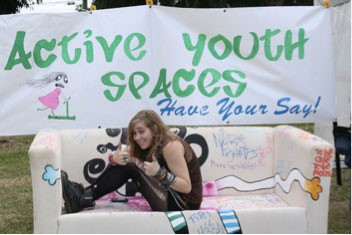
In this post, Bang the Table‘s Engagement Specialist, Jeremy Shackett, explains how to merge hi-tech and low-tech engagement.
When new technology comes along, there is a general anxiety that the old-fashioned way of doing things will disappear. To an extent, it is true. Cars destroyed the horse and buggy industry. Today, Spotify is replacing MP3s, which replaced CDs, which replaced cassette tapes.
In the world of community engagement, however, there is still no substitute for in-person engagement. No matter how advanced the technology becomes, the best examples of community engagement happen when staff use both in-person and online methods to engage.
Here are three ways Bang the Table clients have used the EngagementHQ platform in tandem with innovative in-person approaches.
The Brampton Method
 FutureReady Brampton is using EngagementHQ to gather public input on their community visioning efforts, but on a 100x greater scale than traditional town hall meetings. They use our Ideas tool for the virtual equivalent of Post-it notes, and our Places tool where community members can place pins on the map on areas of concern. Brampton has obliterated our previous record number of ideas on the platform with over 1700 virtual Post-it notes at the time of publication.
FutureReady Brampton is using EngagementHQ to gather public input on their community visioning efforts, but on a 100x greater scale than traditional town hall meetings. They use our Ideas tool for the virtual equivalent of Post-it notes, and our Places tool where community members can place pins on the map on areas of concern. Brampton has obliterated our previous record number of ideas on the platform with over 1700 virtual Post-it notes at the time of publication.
Brampton accomplished this feat by using their Street Team to transcribe ideas they hear from in-person events. Staff have the username ‘streetteam’, and they can transcribe comments they hear at meetings. By combining the two, Brampton can allow members to discuss both in-person and online ideas in one interactive space.
As a side note, branding is also crucial to the success of a project. Brampton’s site is successfully branded because of its consistent visual identity, its tasteful design with bright colors, and streamlined use of the EngagementHQ platform with a focus on interactive content.
The Willoughby Method
Willoughby City Council used EngagementHQ to deploy a new open consultation at the start of every month. The open consultation would feature the newest and most pressing issues in the city for that month, with the engagement limited to perhaps just a simple survey or poll during slow months. Then, at public meetings or in-person events, the team would encourage registration by placing signup sheets at meetings or handing out business cards with registration links.
Willoughby, a city of 74,000, added a modest total of a few dozen participants per month. But because each consultation closed right at the end of the month, it created a sense of urgency and led to a greater proportion of participants commenting. At about 400 participants, Willoughby’s registrations in the first year began to rise more consistently–signaling organic traffic growth from participants introducing their neighbors to the platform. The graph looks to confirm that staff did not need to rely on huge spikes in registration from bulk email imports (as shown in the sharp vertical lines).

The Kingston Couch Method
Kingston City Council sought to engage skaters on a new skatepark project but struggled to reach them through traditional methods.
To solve the problem, Kingston actually began with in-person methods–with a twist. They hauled a white couch to an existing skatepark and asked the skaters to scribble their comments on the couch with a marker. Staff were present to transcribe the comments in the EngagementHQ platform with iPads, then give participants a link to the online forum where they could join the conversation. Lo and behold, in a couple of weeks, some skaters started attending meetings at the Kingston council chambers.
In Perspective

The most pressing challenge with community engagement is ensuring all voices are heard–even those with disability, language, or logistical barriers to participating. It is important to explore online engagement because when it is done properly, it can reach people who face these barriers. A potential pitfall of online engagement, however, is that it tends to cater to those who find it easy to participate–those with speedy internet connections and time on their hands. If you circle back through each of the three methods, you’ll notice that they all required a concerted effort by staff at the beginning. Online tools can help continue the momentum generated by in-person engagement, but it is true that there are limits to a department’s creativity, free time, and budget.
We don’t expect you to harness the power of 1,700 sticky notes every month or become couch-buying regulars at your local thrift store, but in all likelihood, your staff has already used creative ways to engage unique demographics just like these innovative cities. With an online platform, you can continue the momentum that your project generated and bring more people into your conversations.
Supplemental Reading
- Resilient Together: Building a Resiliency Strategy
- The Importance of Compliance in an Engagement Website
- Is Your Engagement Process Really Inclusive?
- Are Your Public Spaces Deterring Community Engagement?
- Top 10 Tips for Planners to Engage the Community
- Heavyweight Online Engagement by Bantamweight Cities
